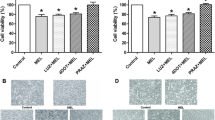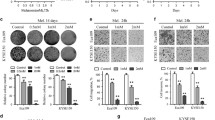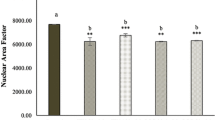Abstract
Melatonin has antitumor activity via several mechanisms including its anti-proliferative and pro-apoptotic effects. Moreover, it has been proven that melatonin in combination with chemotherapeutic agents enhances chemotherapy-triggered apoptosis in several types of cancer. Therefore, this study was intended to evaluate whether melatonin is able to strengthen the anti-cancer potential of different chemotherapeutic drugs in human colorectal adenocarcinoma HT–29 cells. We found that treatment with 20 µM cisplatin (CIS) or 1 mM 5-fluorouracil (5-FU) for 72 h induced a decrease in HT-29 cell viability. Furthermore, 1 mM melatonin significantly (P < 0.05) increased the cytotoxic effects of 5-FU. Likewise, simultaneous stimulation with 1 mM melatonin and 1 mM 5-FU significantly (P < 0.05) enhanced the ratio of cells with an overproduction of intracellular reactive oxygen species and substantially augmented the population of apoptotic cells compared to the treatment with 5-FU alone. Nonetheless, melatonin only displayed moderate chemosensitizing effects in CIS-treated HT-29 cells, as suggested by a slight increment in the fraction of early apoptotic cells that was observed only after 48 h. Consistently, co-stimulation of HT-29 cells with 20 µM CIS or 1 mM 5-FU in the presence of 1 mM melatonin further increased caspase-3 activation. Apart from this, the cytostatic activity displayed by CIS due to S phase arrest was not affected by concomitant stimulation with melatonin. Overall, our results indicate that melatonin increases the sensitivity of HT-29 cells to 5-FU treatment and, consequently, the indolamine could be potentially applied to colorectal adenocarcinoma treatment as a potent chemosensitizing agent.





Similar content being viewed by others
References
Ferlay J, Soerjomataram I, Dikshit R et al (2015) Cancer incidence and mortality worldwide: sources, methods and major patterns in GLOBOCAN 2012. Int J Cancer 136:E359–E386. doi:10.1002/ijc.29210
Scholefield JH, Steele RJ, British Society For Gastroenterology, Association of Coloproctology for Great Britain and Ireland (2002) Guidelines for follow up after resection of colorectal cancer. Gut 51:V3–V5
Hardeland R, Cardinali DP, Srinivasan V et al (2011) Melatonin—a pleiotropic, orchestrating regulator molecule. Prog Neurobiol 93:350–384. doi:10.1016/j.pneurobio.2010.12.004
Trivedi PP, Jena GB, Tikoo KB, Kumar V (2016) Melatonin modulated autophagy and Nrf2 signaling pathways in mice with colitis-associated colon carcinogenesis. Mol Carcinog 55:255–267. doi:10.1002/mc.22274
García-Navarro A, González-Puga C, Escames G et al (2007) Cellular mechanisms involved in the melatonin inhibition of HT-29 human colon cancer cell proliferation in culture. J Pineal Res 43:195–205
Motilva V, García-Mauriño S, Talero E, Illanes M (2011) New paradigms in chronic intestinal inflammation and colon cancer: role of melatonin. J Pineal Res 51:44–60. doi:10.1111/j.1600-079X.2011.00915.x
Kos-Kudla B, Ostrowska Z, Kozlowski A et al (2002) Circadian rhythm of melatonin in patients with colorectal carcinoma. Neuro Endocrinol Lett 23:239–242
Schernhammer ES, Laden F, Speizer FE et al (2003) Night-shift work and risk of colorectal cancer in the nurses’ health study. J Natl Cancer Inst 95:825–828
Naziroglu M, Karaoğlu A, Aksoy AO (2004) Selenium and high dose vitamin E administration protects cisplatin-induced oxidative damage to renal, liver and lens tissues in rats. Toxicology 195:221–230
Sakallı Çetin E, Nazıroğlu M, Çiğ B et al (2017) Selenium potentiates the anticancer effect of cisplatin against oxidative stress and calcium ion signaling-induced intracellular toxicity in MCF-7 breast cancer cells: involvement of the TRPV1 channel. J Recept Signal Transduct Res 37:84–93. doi:10.3109/10799893.2016.1160931
Koşar PA, Nazıroğlu M, Övey İS, Çiğ B (2016) Synergic effects of doxorubicin and melatonin on apoptosis and mitochondrial oxidative stress in MCF-7 breast cancer cells: involvement of TRPV1 channels. J Membr Biol 249:129–140. doi:10.1007/s00232-015-9855-0
Kim J-H, Jeong S-J, Kim B et al (2012) Melatonin synergistically enhances cisplatin-induced apoptosis via the dephosphorylation of ERK/p90 ribosomal S6 kinase/heat shock protein 27 in SK-OV-3 cells. J Pineal Res 52:244–252. doi:10.1111/j.1600-079X.2011.00935.x
Pariente R, Pariente JA, Rodríguez AB, Espino J (2016) Melatonin sensitizes human cervical cancer HeLa cells to cisplatin-induced cytotoxicity and apoptosis: effects on oxidative stress and DNA fragmentation. J Pineal Res 60:55–64. doi:10.1111/jpi.12288
Fan L-L, Sun G-P, Wei W et al (2010) Melatonin and doxorubicin synergistically induce cell apoptosis in human hepatoma cell lines. World J Gastroenterol 16:1473–1481
Plaimee P, Weerapreeyakul N, Barusrux S, Johns NP (2015) Melatonin potentiates cisplatin-induced apoptosis and cell cycle arrest in human lung adenocarcinoma cells. Cell Prolif 48:67–77. doi:10.1111/cpr.12158
Casado-Zapico S, Rodriguez-Blanco J, García-Santos G et al (2010) Synergistic antitumor effect of melatonin with several chemotherapeutic drugs on human Ewing sarcoma cancer cells: potentiation of the extrinsic apoptotic pathway. J Pineal Res 48:72–80. doi:10.1111/j.1600-079X.2009.00727.x
Uguz AC, Cig B, Espino J et al (2012) Melatonin potentiates chemotherapy-induced cytotoxicity and apoptosis in rat pancreatic tumor cells. J Pineal Res 53:91–98. doi:10.1111/j.1600-079X.2012.00974.x
Bejarano I, Espino J, Barriga C et al (2011) Pro-oxidant effect of melatonin in tumour leucocytes: relation with its cytotoxic and pro-apoptotic effects. Basic Clin Pharmacol Toxicol 108:14–20. doi:10.1111/j.1742-7843.2010.00619.x
Espino J, Bejarano I, Paredes SD et al (2011) Protective effect of melatonin against human leukocyte apoptosis induced by intracellular calcium overload: relation with its antioxidant actions. J Pineal Res 51:195–206. doi:10.1111/j.1600-079X.2011.00876.x
Espino J, Rodríguez AB, Pariente JA (2013) The inhibition of TNF-α-induced leucocyte apoptosis by melatonin involves membrane receptor MT1/MT2 interaction. J Pineal Res 54:442–452. doi:10.1111/jpi.12042
Espino J, González-Gómez D, Moreno D et al (2013) Tempranillo-derived grape seed extract induces apoptotic cell death and cell growth arrest in human promyelocytic leukemia HL-60 cells. Food Funct 4:1759–1766. doi:10.1039/c3fo60267b
Longley DB, Harkin DP, Johnston PG (2003) 5-Fluorouracil: mechanisms of action and clinical strategies. Nat Rev Cancer 3:330–338. doi:10.1038/nrc1074
Cassidy J, Saltz L, Twelves C et al (2011) Efficacy of capecitabine versus 5-fluorouracil in colorectal and gastric cancers: a meta-analysis of individual data from 6171 patients. Ann Oncol 22:2604–2609. doi:10.1093/annonc/mdr031
Wang L-H, Li Y, Yang S-N et al (2014) Gambogic acid synergistically potentiates cisplatin-induced apoptosis in non-small-cell lung cancer through suppressing NF-κB and MAPK/HO-1 signalling. Br J Cancer 110:341–352. doi:10.1038/bjc.2013.752
Rodriguez-Garcia A, Mayo JC, Hevia D et al (2013) Phenotypic changes caused by melatonin increased sensitivity of prostate cancer cells to cytokine-induced apoptosis. J Pineal Res 54:33–45. doi:10.1111/j.1600-079X.2012.01017.x
Bejarano I, Redondo PC, Espino J et al (2009) Melatonin induces mitochondrial-mediated apoptosis in human myeloid HL-60 cells. J Pineal Res 46:392–400. doi:10.1111/j.1600-079X.2009.00675.x
Rubio S, Estévez F, Cabrera J et al (2007) Inhibition of proliferation and induction of apoptosis by melatonin in human myeloid HL-60 cells. J Pineal Res 42:131–138. doi:10.1111/j.1600-079X.2006.00392.x
Cos S, Garcia-Bolado A, Sánchez-Barceló EJ (2001) Direct antiproliferative effects of melatonin on two metastatic cell sublines of mouse melanoma (B16BL6 and PG19). Melanoma Res 11:197–201
Majsterek I, Gloc E, Blasiak J, Reiter RJ (2005) A comparison of the action of amifostine and melatonin on DNA-damaging effects and apoptosis induced by idarubicin in normal and cancer cells. J Pineal Res 38:254–263. doi:10.1111/j.1600-079X.2005.00197.x
Bennukul K, Numkliang S, Leardkamolkarn V (2014) Melatonin attenuates cisplatin-induced HepG2 cell death via the regulation of mTOR and ERCC1 expressions. World J Hepatol 6:230–242. doi:10.4254/wjh.v6.i4.230
Büyükavci M, Ozdemir O, Buck S et al (2011) Effect of melatonin on the cytotoxicity of chemotherapeutic drugs in human leukemia cells. In vivo (brooklyn) 25:405–409
Kilic U, Kilic E, Tuzcu Z et al (2013) Melatonin suppresses cisplatin-induced nephrotoxicity via activation of Nrf-2/HO-1 pathway. Nutr Metab (Lond) 10:7. doi:10.1186/1743-7075-10-7
Madhu P, Reddy KP, Reddy PS (2015) Melatonin reduces oxidative stress and restores mitochondrial function in the liver of rats exposed to chemotherapeutics. J Exp Zool A Ecol Genet Physiol 323:301–308. doi:10.1002/jez.1917
Demir MG, Altıntoprak N, Aydın S et al (2015) Effect of transtympanic injection of melatonin on cisplatin-induced ototoxicity. J Int Adv Otol 11:202–206. doi:10.5152/iao.2015.1094
Tan D-X, Manchester LC, Terron MP et al (2007) One molecule, many derivatives: a never-ending interaction of melatonin with reactive oxygen and nitrogen species? J Pineal Res 42:28–42. doi:10.1111/j.1600-079X.2006.00407.x
Xin Z, Jiang S, Jiang P et al (2015) Melatonin as a treatment for gastrointestinal cancer: a review. J Pineal Res 58:375–387. doi:10.1111/jpi.12227
Wei J-Y, Li W-M, Zhou L-L et al (2015) Melatonin induces apoptosis of colorectal cancer cells through HDAC4 nuclear import mediated by CaMKII inactivation. J Pineal Res 58:429–438. doi:10.1111/jpi.12226
Wang J, Guo W, Chen W et al (2013) Melatonin potentiates the antiproliferative and pro-apoptotic effects of ursolic acid in colon cancer cells by modulating multiple signaling pathways. J Pineal Res 54:406–416. doi:10.1111/jpi.12035
Ju H-Q, Li H, Tian T et al (2016) Melatonin overcomes gemcitabine resistance in pancreatic ductal adenocarcinoma by abrogating nuclear factor-κB activation. J Pineal Res 60:27–38. doi:10.1111/jpi.12285
Strasser A, O’Connor L, Dixit VM (2000) Apoptosis signaling. Annu Rev Biochem 69:217–245. doi:10.1146/annurev.biochem.69.1.217
Green DR, Reed JC (1998) Mitochondria and apoptosis. Science 281:1309–1312
Gao Y, Xiao X, Zhang C et al (2017) Melatonin synergizes the chemotherapeutic effect of 5-fluorouracil in colon cancer by suppressing PI3K/AKT and NF-κB/iNOS signaling pathways. J Pineal Res 62:e12380. doi:10.1111/jpi.12380
Acknowledgements
This work was supported by Junta de Extremadura (GR15051). J. Espino holds a research post-doctoral fellowship from Junta de Extremadura (jointly financed by the European Regional Development Fund (ERDF); ref. PO14011). The authors appreciate the technical and human support provided by Facility of Bioscience Applied Techniques of SAIUEx (financed by UEx, Junta de Extremadura, MICINN, FEDER, and FSE).
Author information
Authors and Affiliations
Corresponding author
Ethics declarations
Conflict of interest
All authors declare that they have no conflict of interest.
Rights and permissions
About this article
Cite this article
Pariente, R., Bejarano, I., Rodríguez, A.B. et al. Melatonin increases the effect of 5-fluorouracil-based chemotherapy in human colorectal adenocarcinoma cells in vitro. Mol Cell Biochem 440, 43–51 (2018). https://doi.org/10.1007/s11010-017-3154-2
Received:
Accepted:
Published:
Issue Date:
DOI: https://doi.org/10.1007/s11010-017-3154-2




